
A prasat (Thai: ปราสาท, from Sanskrit: prāsāda), or more accurately, kudakhan (กุฎาคาร, from Pali/Sanskrit: kūṭāgāra) or rueanyot (เรือนยอด), is a Thai architectural form reserved for royal palaces of the monarch or for sacred religious structures. It is a building featuring an ornate roof structure, usually multi-tiered, with one or more spires. The form symbolizes the centre of the universe, which is traditionally associated with the monarch or the Buddha.[1][2] Prasat forms are widely used in the buildings of the Grand Palace, and are also found in some Buddhist temples (wat) and in the architecture of the temporary crematoria used for royal funerals.
Architectural historians have classified kudakhan into several categories, according to the shape of the spire: mondop-shaped, prang-shaped, mongkut-shaped, and others (including stupa-shaped and phra kiao–shaped, depending on the author).[2][3]
Gallery
Mondop-shaped
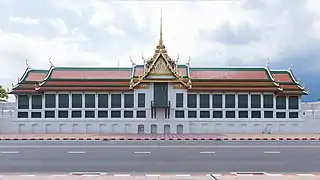 Sutthaisawan Prasat Throne Hall, Grand Palace
Sutthaisawan Prasat Throne Hall, Grand Palace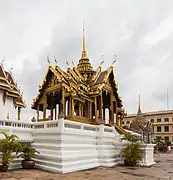 Aphon Phimok Prasat Pavilion, Grand Palace
Aphon Phimok Prasat Pavilion, Grand Palace.jpg.webp) Rueanyot Borom Mangkhalanusorani, Dusit Palace
Rueanyot Borom Mangkhalanusorani, Dusit Palace Aisawan Thipphaya-at Pavilion, Bang Pa-in Palace
Aisawan Thipphaya-at Pavilion, Bang Pa-in Palace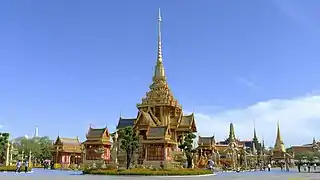 Royal crematorium of Princess Bejaratana
Royal crematorium of Princess Bejaratana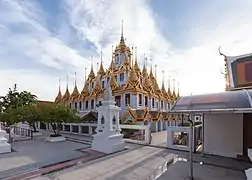 Loha Prasat, Wat Ratchanatdaram
Loha Prasat, Wat Ratchanatdaram
Prang-shaped
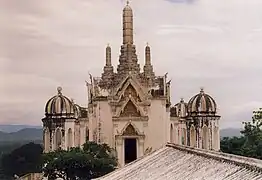 Wetchayan Wichian Prasat Throne Hall, Phra Nakhon Khiri
Wetchayan Wichian Prasat Throne Hall, Phra Nakhon Khiri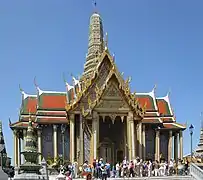 Prasat Phra Thep Bidon, Wat Phra Kaew
Prasat Phra Thep Bidon, Wat Phra Kaew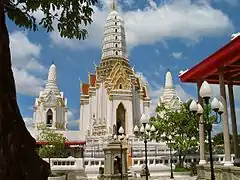
Mongkut-shaped
.jpg.webp) Wihan Yot, Wat Phra Kaew
Wihan Yot, Wat Phra Kaew_02.jpg.webp) Phra Mondop, Wat Pho
Phra Mondop, Wat Pho
See also
- Pyatthat – Burmese equivalent
References
- ↑ Royal Society. พจนานุกรมฉบับราชบัณฑิตยสถาน [Royal Institute Dictionary] (in Thai).
- 1 2 Pastraporn Keanprom (2014). "รูปแบบพระปรางค์และสถาปัตยกรรมที่มียอดปรางค์ในรัชกาลที่ 4–6" [Architectural Style of phra prangs and steeple prangs during the Reign of King Rama IV-VI]. NAJUA: History of Architecture and Thai Architecture (in Thai). 11: 226–253. ISSN 2697-3901. Retrieved 28 January 2020.
- ↑ Athit Limmun (2005). การศึกษากุฎาคารในสมัยรัตนโกสินทร์ [A study on kudakhan in the Rattanakosin period] (PDF) (Master's thesis) (in Thai). Chulalongkorn University. ISBN 974-53-2626-7.